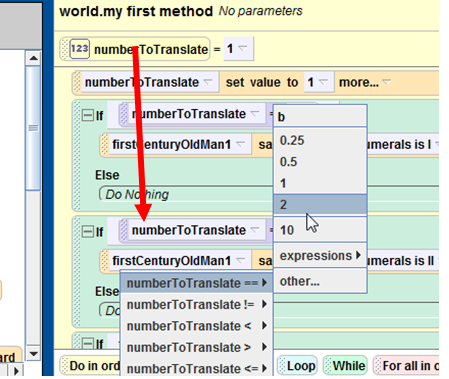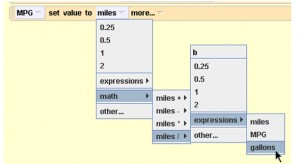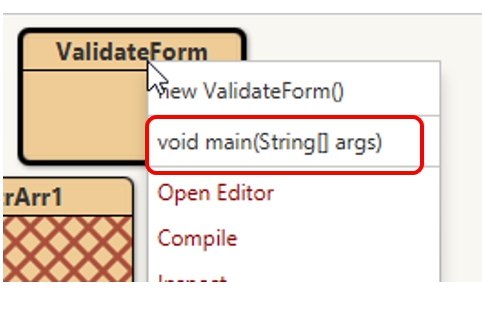Example 1 :
The code below is almost correct , but the variable walkingDistance is never used by the move method !
Code Diagram 1 :
Code Diagram 2 :
Unit 4 . Parameters and Objects [advanced]
Unit 4 . Loops
Unit 3 Datatypes and if/else
Unit 2
Unit 1
Supa Web
Phaser.io resources and links
Unit 4 Bootstrap 4
|
1 2 |
<link rel="stylesheet" href="https://stackpath.bootstrapcdn.com/bootstrap/4.1.3/css/bootstrap.min.css" integrity="sha384-MCw98/SFnGE8fJT3GXwEOngsV7Zt27NXFoaoApmYm81iuXoPkFOJwJ8ERdknLPMO" crossorigin="anonymous"> <script src="https://stackpath.bootstrapcdn.com/bootstrap/4.1.3/js/bootstrap.min.js" integrity="sha384-ChfqqxuZUCnJSK3+MXmPNIyE6ZbWh2IMqE241rYiqJxyMiZ6OW/JmZQ5stwEULTy" crossorigin="anonymous"></script> |
Unit 3 Jquery
Unit 2 Javascript
Unit 1
Mr M Assignment (reproduce the screenshots in the powerpoint)
Useful Links
Useful Websites
Assignment 4.1)
Centigrade to Fahrenheit Modification: Modify the Fahrenheit to centigrade project as follows.
Assignment 4.2)![]()
Miles Per Gallon Modification: Modify the miles per gallon project in the same way as the prior exercise.
4.25 ) Guess Animal’s weight assignment
Assignment 4.3) Open assignment. Your open project must have each of the following criteria
FIRST: make sure you know: how to use What as a String and perform Math expressions . You will not be able to do this assignment until you understand both of the above lessons.
Reference packets : #11, #12
Create a world that has a character (person/penguin/whatever) that will ask the user for the height of a triangle and the base of a triangle, and calculate its area
![]()
Objective : to let the user type in a number between 1 and 10 and then have a character “translate” that into Roman Numerals ( I, II, III, IV, V, VI, VII, VIII, IX, X)

Final result :
We are going to use the roman Numeral Translator file again, so it’s important that you don’t lose the file and give it a good name that you can easily recognize in the future.
Extra credit: Translate 1-20 (Note : You still need to display an error if they enter a number that is too big, which in this case would be >21)
Create a world in which the


|
1 |
MPG = miles/gallons |
Lastly,
|
1 |
degreesCentigrade = (5/9) * (degreesFahrenheit − 32) |
People collection to say the centigrade temperature.
Assignment 5) Circle’s Area and Circumference: Create a world with your choice of person from the Peoplecollection. When you play the world, it should
Assignment 5-extra credit ). Look up the formulas for the volume and surface area of a cylinder . Ask the user for the height of the cylinder and the radius, which should be stored in variables. Then calculate the surface area and volume of the cylinder . See if there is a cylinder shape in the gallery to use as a visual aid. And have an object say the volume and surface areas.
|
1 2 3 4 5 6 7 8 9 10 11 12 |
void nestedLoopDemo(){ for (int row = 1 ; row <= 4 ; row++) { System.out.print("row "+ row + " : ") ; for (int star = 1 ; star <= row ; star++) { System.out.print("* ") ; } System.out.println() ; } } |
Change the code from the demonstration of nested loops so that you output the following pattern below. Call this method printSqure()
diagAndBrders() noDiag()
printMultiplicationTable()
In this lab, you will work with a GUI to validate the input in each text field . Below is a screenshot of the running program.


If the user has no errors, then please show the message “Thanks for submitting your information ” , as shown below
A file that does a few test cases (be careful not to overwrite your work)
VIM is a very powerful editor.
Follow the steps below to set it up. I am using windows and you might need to slightly modify certain steps like #2 for Mac (not sure)
1) first install git : https://git-scm.com/downloads
For Windows:
Download and run the executable installer
2) Uncheck “make plugin directory” at install. (We will create our own folder called “bundle” later that serves the same purpose)
For Mac:
(consider macvim and/or using homebrew)

For steps 3 and 4, you can just download this folder: bundle (unzip it and put it into your main Vim folder, as shown in picture above), or you can follow steps 3 and 4
3) create a folder called “bundle” in the core vim folder.
4) in “bundle”, you must put the vundle.vim folder (see picture at bottom). You must put Vundle.vim inside bundle.
5) Create a folder called ‘tmp’ . We will configure our vimrc to store temporary files there (Otherwise, they get saved in CWD and youre directories end up getting littered with lots of ugly temporary vim files)
6) Feel free to use my customized _vimrc . That file should be in your root vim folder as you can see in the screenshot at the bottom. (BTW, you must remove the “.txt” extension.)
7)Run Gvim . (If you’re using my vimrc , you’ll get an error first time, but that’s ok). The actual gVim application is in the folder called vim80 (or whatever version of gVim you’re running. If you installed vim 7.9, then you’d look in the vim79 folder or the like)
8)Let’s install some plugins using Vundle. To do, just type: the following
:PluginInstall (Yes, do type the the colon)
To type you must press either “i” or “a” which puts you into insert mode.
Both classes
Should watch “history of php” from https://www.lynda.com/MySQL-tutorials/PHP-MySQL-Essential-Training/119003-2.html
and then
“configuring php” from https://www.lynda.com/MySQL-tutorials/PHP-MySQL-Essential-Training/119003-2.html
Then go to the appropriate video course
NOTE: if you were in CS II last year, you *must* use Option 1, unless you get permission from me.
| PHP Web Design | PHP Mysql |
|
Skip introduction, do everything else Unit 1 |
Skip installation, go right to “first steps” |
Quarter 3
NOTE: if you were in CS II last year, you *must* use Option 1, unless you get permission from me.
You should use Option 2 if you either a) feel confident in your programming background or have experience programming outside of the class 2) took the AP class last year.
SKIP Installation unit except for Configuring php
Full assignment breakdown here
Below are some courses that you can explore as you consider ramping up your skills for the 4th quarter independent study.
Quarter 4
This quarter will be comprised of an extended independent project that can be focused on anything web related. Note: If you are taking next year’s AP class, you must choose a rigorous programming project.
a) choosing a long term project that requires extended learning. At least 1-3 Lynda.com classes (I will need to see that you completed 100% of at least 1 class)
b) you must write a proposal that details